
Callowhill is one of the unofficial names for a neighborhood in Philadelphia, Pennsylvania, located roughly in the vicinity of Callowhill Street, between Vine, Spring Garden, Broad, and 8th streets. The name "Callowhill" was coined by the Callowhill Neighborhood Association, a community organization in the area; although this name often appears on online maps, the City of Philadelphia does not have an official name for this area. Callowhill is named for Callowhill Street, which was named after Hannah Callowhill Penn, William Penn's second wife and de facto proprietor of Pennsylvania after William Penn.

Philadelphia's Baltimore and Ohio Railroad station – also known as the B & O station or Chestnut Street station – was the main passenger station for the Baltimore and Ohio Railroad in Philadelphia, Pennsylvania. Designed by architect Frank Furness in 1886, it stood at 24th Street and the Chestnut Street Bridge from 1888 to 1963.
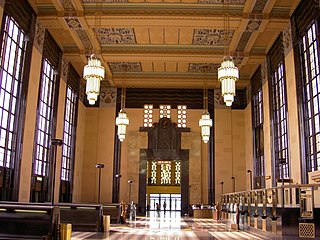
The Union Station, at 801 South 10th Street in Omaha, Nebraska, known also as Union Passenger Terminal, is "one of the finest examples of Art Deco architecture in the Midwest". Designated an Omaha Landmark in 1978, it was listed as "Union Passenger Terminal" on the National Register of Historic Places in 1971, and was designated a National Historic Landmark in 2016. The Union Station is also a contributing property to the Omaha Rail and Commerce Historic District. It was the Union Pacific's first Art Deco railroad station, and the completion of the terminal "firmly established Omaha as an important railroad terminus in the Midwest".

Cà d'Zan is a Mediterranean revival residence in Sarasota, Florida, adjacent to Sarasota Bay. Cà d'Zan was built in the mid-1920s as the winter retreat of the American circus mogul, entrepreneur, and art collector John Ringling and his wife Mable Burton Ringling. The name Cà d'Zan means "House of John" in the Venetian language; in Italian it would be "Casa di Giovanni".

Poplar is a neighborhood in Lower North Philadelphia, Pennsylvania, United States. It is located north of Callowhill, between Spring Garden/Fairmount and Northern Liberties, bounded roughly by Girard Avenue to the north, North Broad Street to the west, Spring Garden Street to the south, and 5th Street to the east. The neighborhood is predominantly residential, with commercial frontage on Broad Street and Girard Avenue and some industrial facilities to the west of the railroad tracks along Percy St. and 9th St.

The United States Custom House is a historic United States federal government building in Philadelphia, Pennsylvania. Built between 1932 and 1934 to the Art Deco designs of the architectural firm of Ritter & Shay, the building occupies an entire block between Second, Chestnut, and Sansom Streets and the former Exchange Place in the heart of the oldest section of the city. Its south and west sides border Independence National Historical Park.

The H. J. Heinz Company complex, part of which is currently known as Heinz Lofts, is a historic industrial complex in the Troy Hill neighborhood of Pittsburgh, Pennsylvania. The buildings were built by the H. J. Heinz Company from 1907 through 1958. The complex is listed on the National Register of Historic Places (NRHP) and five of the buildings are listed as a Pittsburgh History and Landmarks Foundation Historic Landmark.
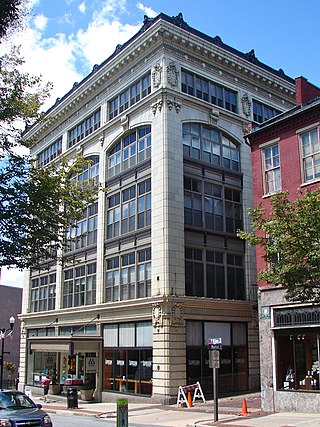
The Hager Building is an historic commercial building which is located in Lancaster, Lancaster County, Pennsylvania. Designed by noted Lancaster architect C. Emlen Urban, it was built between 1910 and 1911.
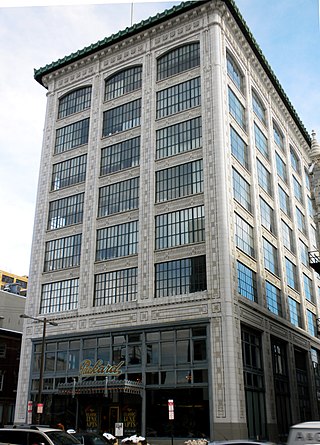
The Packard Motor Car Company Building, also known as the Press Building, is an historic, American office building that is located at 319 North Broad Street between Pearl and Wood Streets in the Callowhill neighborhood of Philadelphia, Pennsylvania.

The Pitcairn Building, also known as the Pittsburgh Plate Glass Company Building, is an historic, American warehouse and light manufacturing loft building that is located at 1027 Arch Street at the corner of North 11th Street in the Chinatown neighborhood of Philadelphia, Pennsylvania.

The Rafsnyder-Welsh House is an historic, American home that is located in the Rittenhouse Square East neighborhood of Philadelphia, Pennsylvania.

Horace Jayne House (1895) is an architecturally significant building designed by architect Frank Furness in Philadelphia, Pennsylvania, United States. It is located at the southwest corner of 19th and Delancey Streets, about a block south of Rittenhouse Square.

The Goodman Brothers and Hinlein Company is an historic factory building which is located at 1238 Callowhill Street in the Callowhill neighborhood of Philadelphia, Pennsylvania.

The Philadelphia Wholesale Drug Company Building is an historic, American warehouse building that is located in the Callowhill neighborhood of Philadelphia, Pennsylvania.

The Smaltz Building, also known as the Smaltz-Goodwin Building, is an historic, American factory building that is located in the Callowhill neighborhood of Philadelphia, Pennsylvania.
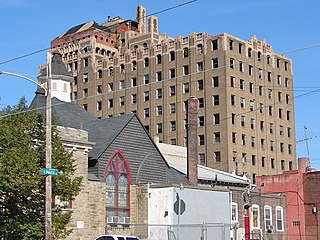
National Bank of North Philadelphia,, is a historic bank building located in the Nicetown-Tioga neighborhood of Philadelphia, Pennsylvania. The original section was built in 1926, and is a 10- to 11-story, limestone, brick and terra cotta building in the Art Deco style. It is topped by a three-story penthouse with a pyramidal roof.
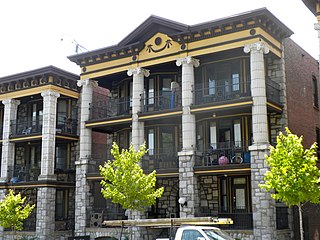
The Breslyn Apartments is an historic apartment complex which is located in the Spruce Hill neighborhood of Philadelphia, Pennsylvania.

Callowhill Industrial Historic District is a national historic district located in the Callowhill neighborhood of Philadelphia, Pennsylvania. It encompasses 31 contributing buildings, 1 contributing site, and 1 contributing structure. The commercial and industrial buildings were mostly built from the 1890s through the 1930s. They range from 4 to 14 stories in height and the exteriors are of brick, concrete, terra cotta, and stone. Most of the buildings are characterized as box-shaped, mid-rise loft buildings with flat roofs. Also in the district are eleven 2+1⁄2-story brick rowhouses, with the earliest dated to the 1830s. Notable buildings include the Rebman Building (1903), Stewart Cracker Building, U.S. Tire Company Building (1911), Lasher Building (1927), Philadelphia City Morgue (1928), and Overland Motor Company Building. Located in the district and listed separately are the Smaltz Building (1912), Terminal Commerce Building, Goodman Brothers and Hinlein Company, and the Packard Motor Corporation Building.
The William Steele & Sons Company was an architectural firm that was located in Philadelphia, Pennsylvania.
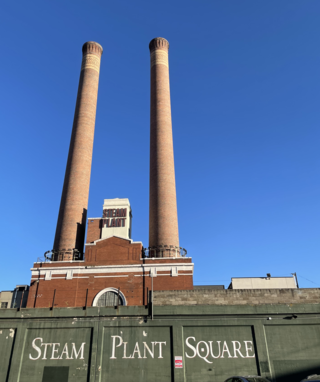
The Central Steam Heat Plant, commonly known as Steam Plant Square, or simply as the Steam Plant, is a historic building in Downtown Spokane, Washington. Originally built to provide steam heating to more than 300 buildings in Spokane's city center, the Steam Plant served that purpose until the 1980s, when it was no longer viable. In the 1990s, the Steam Plant and adjacent Seehorn-Lang Building were converted into Steam Plant Square, a commercial, retail and restaurant center. The conversion maintained many of the industrial steam plant structures such as furnaces, boilers, catwalks and pipe networks, which can still be seen and explored by visitors and patrons. The Steam Plant's pair of 225-foot-tall stacks have been a unique and iconic aspect of the city's skyline for more than a century, and are illuminated from their base at night. If the stacks were considered to be a building, they would rank as the third tallest in the city.
























